Discover 6 hidden attractions, cool sights, and unusual things to do in Chillicothe (United States). Don't miss out on these must-see attractions: St. Columban Catholic Church, Chillicothe Commercial Historic District, and Fredericktown Courthouse Square Historic District. Also, be sure to include Grace Episcopal Church in your itinerary.
Below, you can find the list of the most amazing places you should visit in Chillicothe (Missouri).
Table of Contents
St. Columban Catholic Church
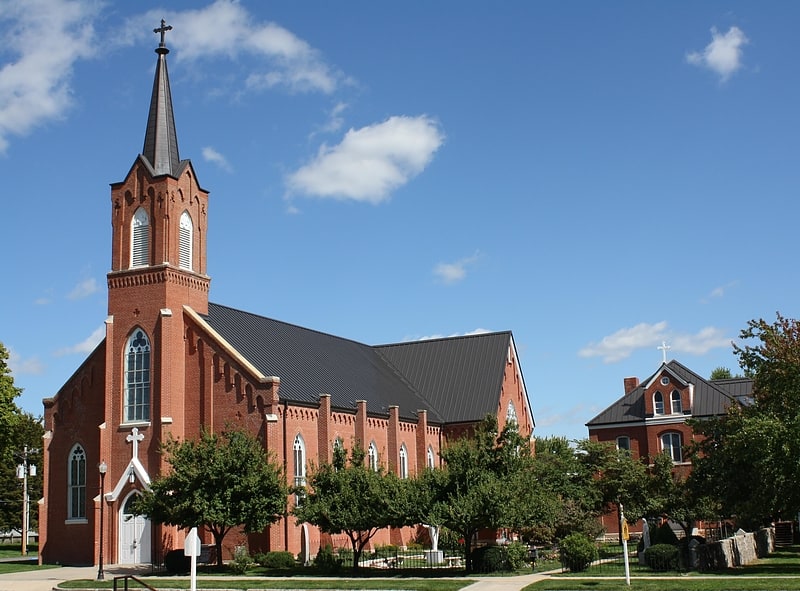
Catholic church in Chillicothe, Missouri. This is the history of St. Columban parish in Chillicothe, Missouri.
The first St. Columban church was built in 1858 by John Joseph Hogan, who became the first Bishop of the Diocese of Saint Joseph in 1868.
In 1872, St. Joseph's Academy boarding and day school (to the left) began its 97-year tradition. In 1917 the first boy was admitted. The Sisters of St. Joseph of Carondelet in St. Louis ran the school for 63 years, until 1935 when the Sisters of St. Francis of Savannah replaced them. In 1905 the Franciscans would write: "The prosperous condition of the Church in Chillicothe is greatly due to the Academy."
The Friars Minor, who had come to the United States in 1875 fleeing the Kulturkampf in Germany, came to Chillicothe in 1878 at the invitation of Hogan. They took charge of the parish and the next year, across Trenton Street from the Academy, built the present church, designed by Franciscan Brother Adrian Wewer. In 1880 a parish elementary school, College Hall, opened.
In 1892 the present rectory was built as a Franciscan monastery with 30 rooms plus a spacious attic. The previous rectory was located directly to the east of the church and needed to be moved to make way for an expansion of the church building. The parish then numbered about 100 families, fairly evenly divided between farmers, railroad people, and other business people. In 1894 the church was expanded, adding an apse and two transepts containing large stained-glass windows made by George A. Misch and Brothers of Chicago. The south window depicts the three patrons of the Franciscan order: St. Clare, St. Louis IX, King of France, and St. Elizabeth. The north window shows the Holy Family of Jesus, Mary, and Joseph. The four stained-glass windows in the apse depict St. Francis receiving the stigmata, the Annunciation, the child Jesus appearing to St. Anthony, and St. Margaret Mary Alacoque receiving the devotion to the Sacred Heart. Much of the statuary dates back to the late 19th century and was manufactured in Munich, Germany.
In 1895 St. Joseph church (left) was built just south of the railroad tracks on the east side of the highway, and the parish was divided at Jackson Street. St. Joseph closed in 1956, to the dismay of some in its close-knit community.
A census taken in 1904 counted 42 German families, mostly farmers, 56 Irish families, mostly railroad workers, and 8 French families. In 1904 a new, white-oak main altar with ornate reredos was constructed, along with an additional two side altars of white walnut dedicated to St. Joseph and St. Anthony (right). The side altars of the Sacred Heart and the Blessed Mother were original to the church and also made of white walnut. By 1907 the parish census counted 738 people. The Catholic influence in the Chillicothe area was evidenced by the Franciscan's Historical Sketches of the parish (1905), which contained over 100 advertisements of one-quarter page or more.
In 1910, a German-crafted nativity scene set with near life-size figures was purchased, and after a century is still in use. In 1913 Thomas Bush painted a mural above each outer side altar: Jesus Healing and Jesus at the home of Martha and Mary. Additionally, murals of the Ascension and Assumption were painted on both sides of the main altar. In 1913 St. Columban elementary school was built (to the right), and currently serves as classrooms for pre-school, kindergarten, first grade, music, and middle school science. In July 1914, the Franciscans left the parish and diocesan priests managed the parish until 1971 when Benedictine monks from Conception Abbey took charge. In 1998 the Benedictines left and the parish reverted to the diocese.
In 1957 the St. Joseph Academy building was razed to make way for Bishop Hogan Elementary School (left), which currently enrolls around 140 students in preschool through 8th grade. The academy moved to the St. Columban School building and continued until 1969, when the building was converted for pre-school and elementary use.
The church building has a shrine-like atmosphere with 32 statues, 4 murals, 2 paintings, beautiful stained-glass windows, and stations of the cross. An additional 10 statues are located in a small park/shrine to Mary to the south of the church. In 2015 the parish counted 460 families.
In 2017, the interior of the church was restored back to what it looked like at its artistic height in 1914 (see before (left) and after (right)). The first mass celebrated in the newly restored church was held on August 6, 2017.
In 2018, the communion rail was restored and put back in place.
The interior of the rectory was restored in 2021.[1]
Chillicothe Commercial Historic District
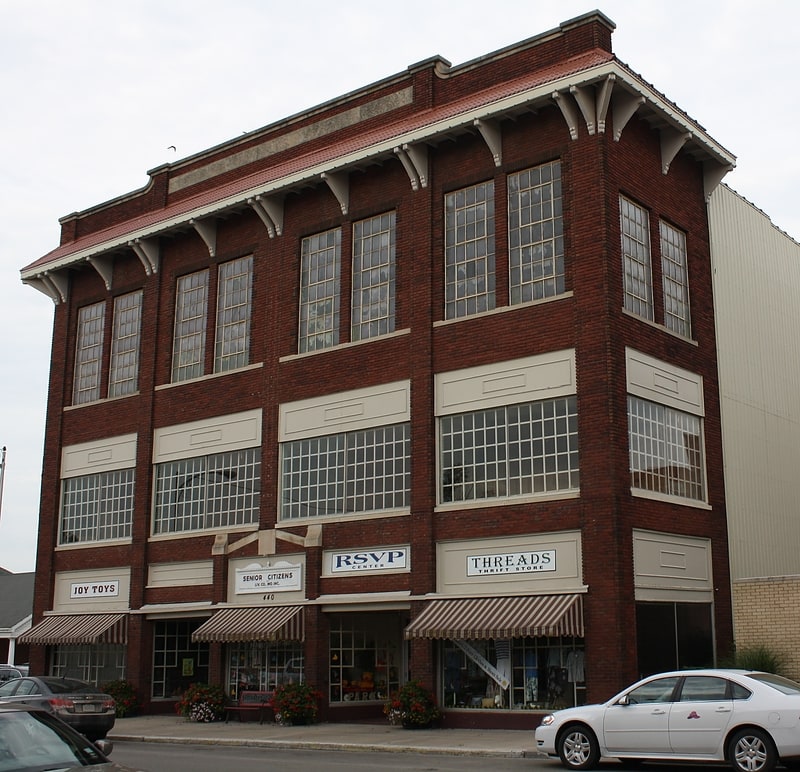
Historical landmark in Chillicothe, Missouri. Chillicothe Commercial Historic District is a national historic district located at Chillicothe, Livingston County, Missouri. The district encompasses 24 contributing buildings in the central business district and surrounding residential area of Chillicothe. It developed between about 1889 and 1950, and includes representative examples of Queen Anne, Italianate, Beaux Arts, Mission Revival, and Art Deco style architecture. Notable buildings include the Scruby Brothers Building, S. A. Stone Building, Dairy Creme Building, Strand Coffee Shop Building, Strand Hotel and Garage, Norman & Jarvis Funeral Home Building, Empire Theatre, Chillicothe Post Office/Federal Building, Grace & Simpson Apartments, and Loomis Building/Chillicothe Post Office.
It was listed on the National Register of Historic Places in 2002.[2]
Fredericktown Courthouse Square Historic District
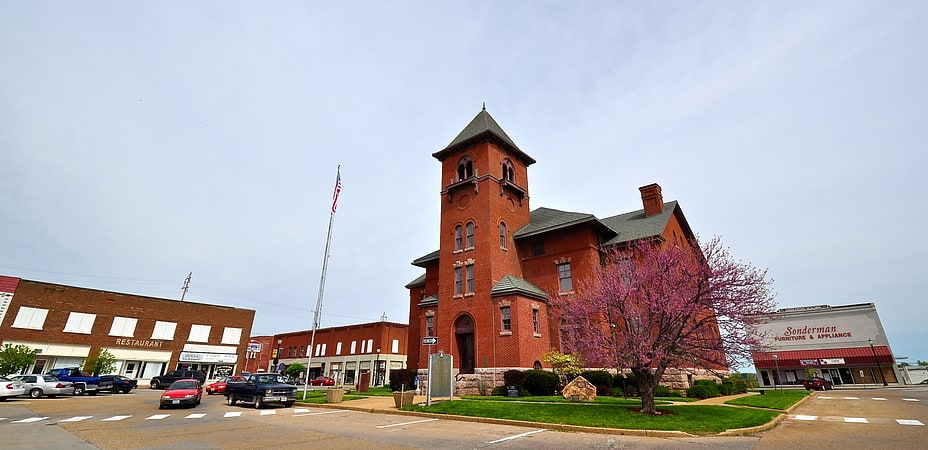
Fredericktown Courthouse Square Historic District is a national historic district located at Fredericktown, Madison County, Missouri. The district encompasses 26 contributing buildings in the central business district of Fredericktown. It developed between about 1819 and 1958, and includes representative examples of Renaissance Revival, Italianate, and Art Deco style architecture. Located in the district is the separately listed Madison County Courthouse designed by Theodore Link. Other notable buildings include the Old Livery, I.O.O.F. Hall, Masonic Hall, Madison Hotel, and Democrat News.
It was listed on the National Register of Historic Places in 2009.[3]
Grace Episcopal Church
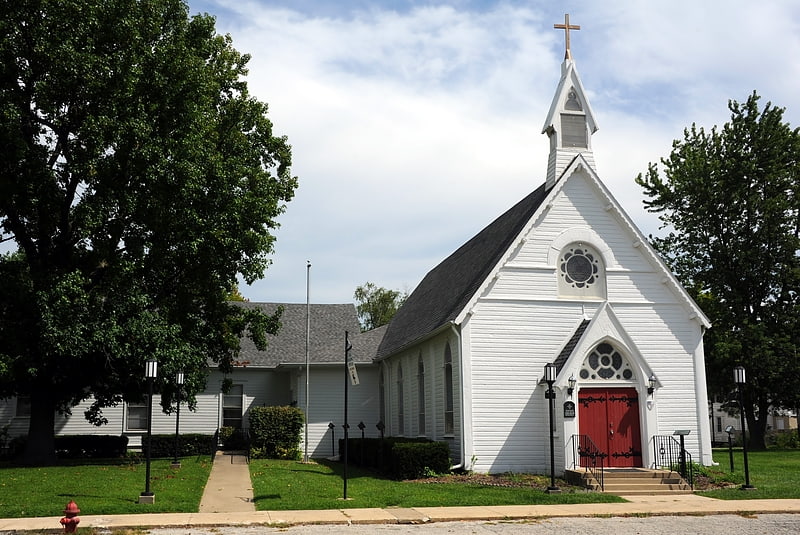
Episcopal church in Chillicothe, Missouri. Grace Episcopal Church is a historic Episcopal church in Chillicothe, Livingston County, Missouri. The church was built between 1867 and 1869, and is a one-story, inexpensive prefabricated wooden church patterned after Early English Gothic churches. The church measures approximately 69 feet by 22 feet and is connected to the Andrew Leeper Memorial Parish Hall by a rectangular foyer.
It was listed on the National Register of Historic Places in 1980.[4]
Courthouse Square Historic District
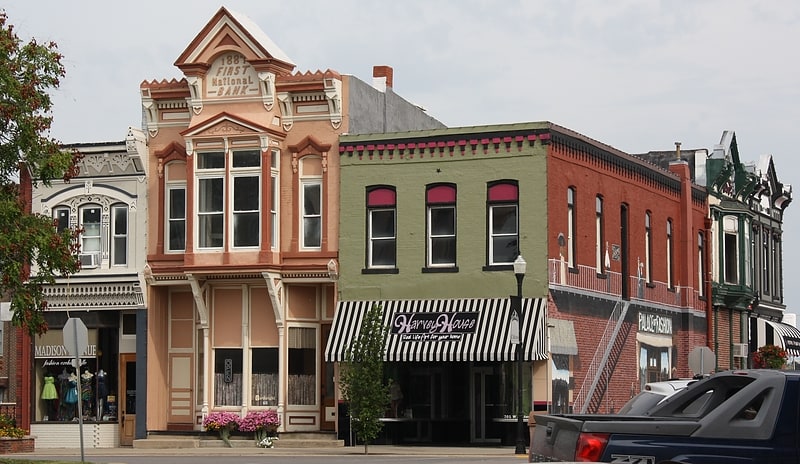
Courthouse Square Historic District is a national historic district located at Chillicothe, Livingston County, Missouri. The district encompasses 24 contributing buildings in the central business district and surrounding residential area of Chillicothe. It developed between about 1877 and 1950, and includes representative examples of Late Victorian and Beaux Arts style architecture. Notable buildings include the Livingston County Courthouse, Wallbrunn Building, First National Bank Building #2, Peoples Trust Building, Nick J. Rensch Building, Davis/Milbank Building, Leeper Hotel, Chillicothe City Hall, First National Bank Building #1, and Sipple Clothing Co/Broyles Land Co Building.
It was listed on the National Register of Historic Places in 2002.[5]
Chillicothe Industrial Home for Girls
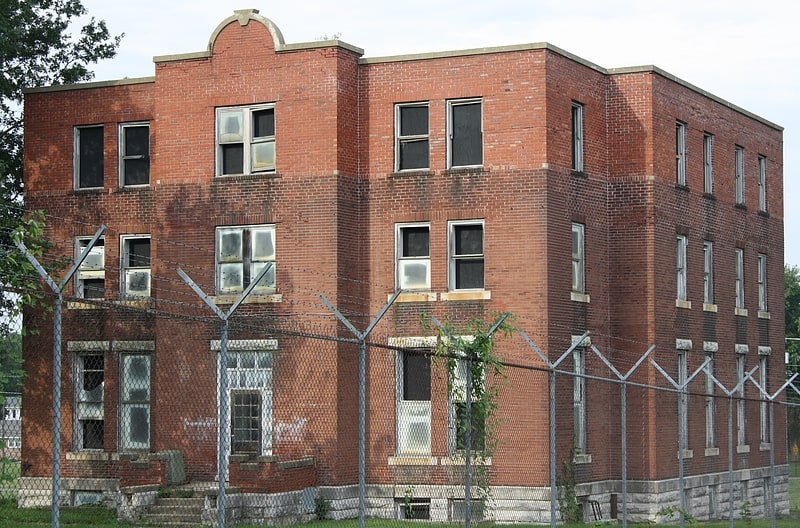
Historical place in Chillicothe, Missouri. Chillicothe Industrial Home for Girls, also known as Chillicothe Correctional Center, is a national historic district located at Chillicothe, Livingston County, Missouri. The district encompasses 10 contributing buildings, 1 contributing site, and 7 contributing structures, at a former industrial home. It developed between about 1889 and 1970, and includes representative examples of Colonial Revival and Streamline Moderne style architecture. Notable buildings include the McReynolds Cottage by Morris Frederick Bell, who also designed the original campus; Blair Cottage; Hearnes Office Building and Clinic; Donnelly Cottage; Stark Cottage; Hyde School; Park Cottage; Food Service Building; Laundry; Power House. The home officially closed as a juvenile facility in 1980 and re-opened as an adult correctional center in 1981. The new Chillicothe Correctional Center opened in 2008, and the former Industrial Home site was declared surplus.
It was listed on the National Register of Historic Places in 2010.[6]